TOCPythonLanguageCode LineCode BlockFunctionsCommon PackagesResource and LinkKnowledge BaseHow ToFAQ
Draft for Information Only
Content
Python Textual Sequence Types
Python Textual Strings
Python Textual Literals
Python Textual Constructor
class 𝑠𝑡𝑟
Parameter
Remarks
Source and Reference
Python Textual Sequence Types
Python textual data is implemented as Python string which may be handled by predefinedPython Textual Strings
The Python textual sequence of Python strings are stored as immutable sequences of Unicode code points internally. The type constructor of Python strings is designed to handled all kinds of Python textual data for both representation of printable string or byes like objects. Python does not have an individual character type for Python textual sequence of Python string, the indexing of a Python string produces strings of length 1. e.g. for a non-empty string s,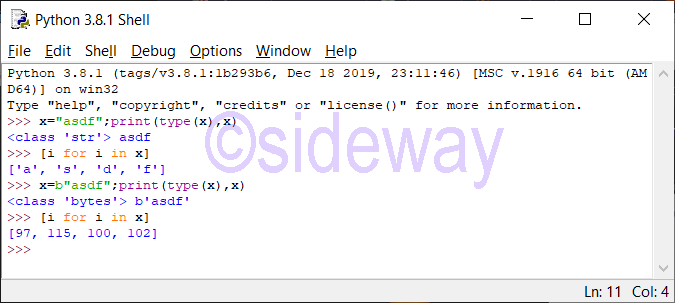
Python Textual Literals
Python textual strings may be coustrusted by textual literals, string and bytes literals, directly. Besides, a single expression of several textual literals separated by whitespace only will be implicitly converted to a single textual literal. String LiteralsSingle quotes: For allowing embedded double quotes. e.g. 'allows embedded "double" quotes' Double quotes: For allowing embedded single quotes. e.g. "allows embedded 'single' quotes" Triple quoted: For allowing embedded single and double quotes. Besides triple quoted strings may span multiple lines and all associated whitespace will be included in the string literal. e.g. '''Three single quotes''', """Three double quotes"""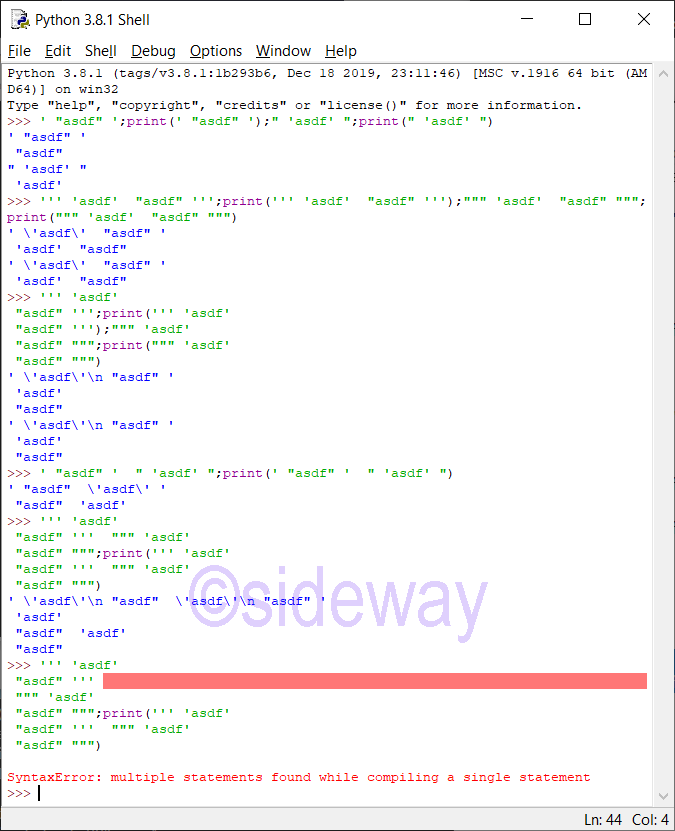 Bytes LiteralsSingle quotes: For allowing embedded double quotes. e.g. b'allows embedded "double" quotes'
Double quotes: For allowing embedded single quotes. e.g. b"allows embedded 'single' quotes"
Triple quoted: For allowing embedded single and double quotes. Besides triple quoted strings may span multiple lines and all associated whitespace will be included in the bytes literal. e.g. b'''Three single quotes''', b"""Three double quotes"""
Bytes LiteralsSingle quotes: For allowing embedded double quotes. e.g. b'allows embedded "double" quotes'
Double quotes: For allowing embedded single quotes. e.g. b"allows embedded 'single' quotes"
Triple quoted: For allowing embedded single and double quotes. Besides triple quoted strings may span multiple lines and all associated whitespace will be included in the bytes literal. e.g. b'''Three single quotes''', b"""Three double quotes"""
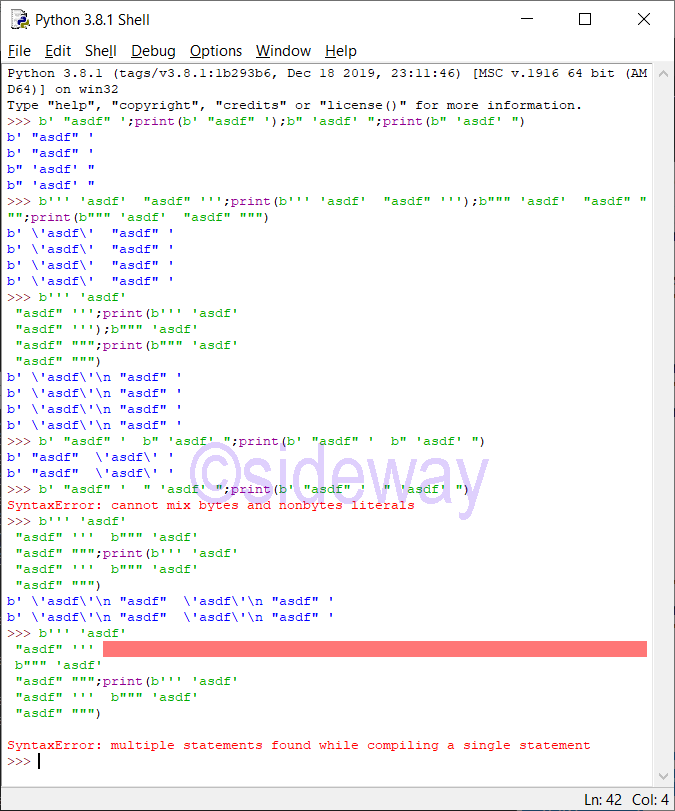
Python Textual Constructor
class 𝑠𝑡𝑟
class 𝑠𝑡𝑟(object='')
class 𝑠𝑡𝑟(object=b'', encoding='utf-8', errors='strict')Parameter
class 𝑠𝑡𝑟To return a string version of object. The behavior ofRemarks
- For calling
𝑠𝑡𝑟()function with neitherencodingnorerrorsargument is given, the𝑠𝑡𝑟(object)function returnsobject.__str__(), the informal readable printing string representation of theobject. If the givenobjectis a string object, the return is the string itself. Ifobjectdoes not have a__str__()method, then𝑠𝑡𝑟()returnsrepr(object), the formal Python informative string presentation of theobject.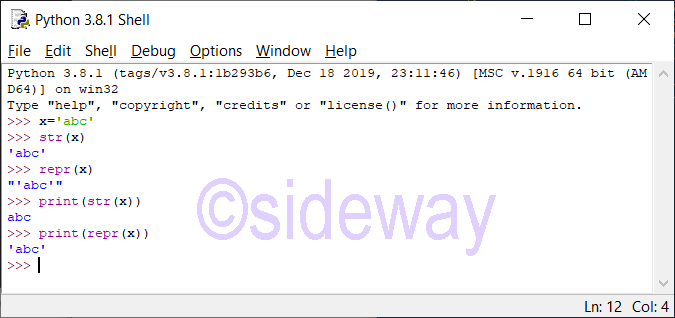
- For calling
𝑠𝑡𝑟()function with at least oneencodingorerrorsargument is given, theobjectshould be a bytes-like object, e.g.bytesorbytearray. Or may cause TypeError. The function itself,𝑠𝑡𝑟(bytes, encoding, errors)is equivalent tobytes.decode(encoding,errors).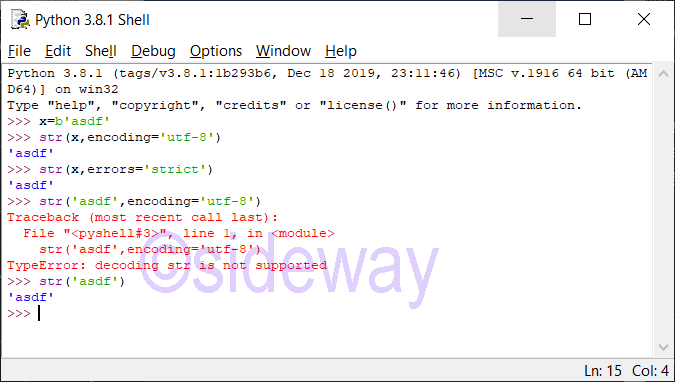
- However, when calling
𝑠𝑡𝑟()function with neitherencodingnorerrorsargument is given for a bytes-like object, the𝑠𝑡𝑟()function returns the informal string representation as in the first case.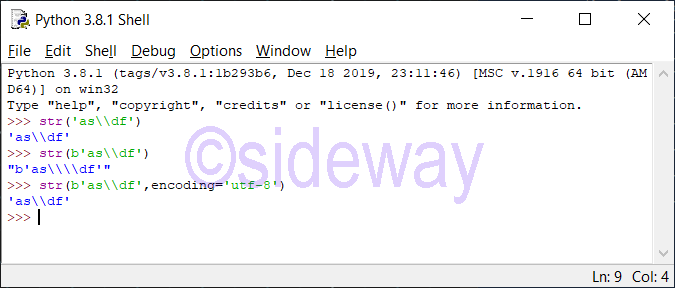
Source and Reference
©sideway
ID: 210100012 Last Updated: 1/12/2021 Revision: 0
Latest Updated Links
- Legrand Galion(last updated On 12/2/2025)
- Schneider Electric AvatarOn(last updated On 12/1/2025)
- Alfalux(last updated On 11/30/2025)
- Novabell(last updated On 11/29/2025)
- TownGas NJW12RM1(last updated On 11/28/2025)
- SamSung 42" OLED TV S90F 4K(last updated On 11/27/2025)
- Tefal KI7208 GLASS VISION KETTLE(last updated On 11/26/2025)
- Tefal BL83SD PerfectMix Cook Blender(last updated On 11/25/2025)
- Tefal KI7208 GLASS VISION KETTLE(last updated On 11/24/2025)
- Hitachi RD-290GX Dehumidifier(last updated On 11/23/2025)
- Hitachi RD-290GX Dehumidifier(last updated On 11/22/2025)

 Nu Html Checker
Nu Html Checker  53
53  na
na  na
na
Home 5
Business
Management
HBR 3
Information
Recreation
Hobbies 9
Culture
Chinese 1097
English 339
Travel 18
Reference 79
Hardware 54
Computer
Hardware 259
Software
Application 213
Digitization 37
Latex 52
Manim 205
KB 1
Numeric 19
Programming
Web 289
Unicode 504
HTML 66
CSS 65
SVG 46
ASP.NET 270
OS 431
DeskTop 7
Python 72
Knowledge
Mathematics
Formulas 8
Set 1
Logic 1
Algebra 84
Number Theory 206
Trigonometry 31
Geometry 34
Calculus 67
Engineering
Tables 8
Mechanical
Rigid Bodies
Statics 92
Dynamics 37
Fluid 5
Control
Acoustics 19
Natural Sciences
Matter 1
Electric 27
Biology 1
